Distinguishing Time Scales of Katabatic Flow in Complex Terrain
Abstract
:1. Introduction
2. Materials and Methods
3. Results
3.1. Drainage Flow Identification
3.1.1. Tower Transect
3.1.2. Diurnal Evolution of Near-Surface Temperature
3.2. Lapse Rate Scale Dependencies
3.2.1. Dependency of Near-Surface Lapse Rate to Flow Channel Proximity
3.2.2. Dependency of Near-Surface Lapse Rate to Downslope Distance (Range)
3.3. Cooling Rate Scale Dependencies
3.3.1. Dependency of Cooling Rate to Height and Day/Night Transition
3.3.2. Dependency of Cooling Rate to Slope Angle
3.3.3. Basin-Scale Cooling Rate
4. Discussion
5. Conclusions
- At local scales, the critical length scale is position relative to a local drainage feature. It is likely that advection through these local features account for a disproportionate amount of the total transport (the timescales are faster) but local-scale flux measurements to verify this hypothesis were unavailable during the MATERHORN experiment;
- With increasing spatial and temporal scale, slope and range become the most important causative spatial variables;
- Katabatic wind speed at a given location downrange is therefore an integration of local and basin scale contributions, both of which evolve in magnitude following shade front passage.
Author Contributions
Funding
Institutional Review Board Statement
Informed Consent Statement
Data Availability Statement
Acknowledgments
Conflicts of Interest
References
- Papadopoulos, K.H.; Helmis, C.G.; Soilemes, A.T.; Kalogiros, J.; Papageorgas, P.G.; Asimakopoulos, D.N. The structure of katabatic flows down a simple slope. Q. J. R. Meteorol. Soc. 1977, 123, 1581–1601. [Google Scholar] [CrossRef]
- Kondo, J.; Sato, T. A simple model of drainage flow on a slope. Bound.-Layer Meteorol. 1988, 43, 103–123. [Google Scholar] [CrossRef]
- Barr, S.; Kyle, T.G.; Clements, W.E.; Sedlacek, W. Plume dispersion in a nocturnal drainage wind. Atmos. Environ. 1983, 17, 1423–1429. [Google Scholar] [CrossRef]
- Yasuda, N.; Kondo, J.; Sato, T. Drainage flow observed in a V-shaped valley. J. Meteorol. Soc. Jpn. Ser. II 1986, 64, 283–301. [Google Scholar] [CrossRef] [Green Version]
- Wilson, J.G.; Kingham, S.; Sturman, A.P. Intraurban variations of PM10 air pollution in Christchurch, New Zealand: Implications for epidemiological studies. Sci. Total Environ. 2006, 367, 559–572. [Google Scholar] [CrossRef]
- Bale, J.S.; Harrington, R.; Clough, M.S. Low temperature mortality of the peach-potato aphid Myzus persicae. Ecol. Entomol. 1988, 13, 121–129. [Google Scholar] [CrossRef]
- Lindkvist, L.; Chen, D. Air and soil frost indices in relation to plant mortality in elevated clear-felled terrain in Central Sweden. Clim. Res. 1999, 12, 65–75. [Google Scholar] [CrossRef] [Green Version]
- Darby, L.S.; Poulos, G.S. The evolution of lee-wave–rotor activity in the lee of Pike’s Peak under the influence of a cold frontal passage: Implications for aircraft safety. Mon. Weather Rev. 2006, 134, 2857–2876. [Google Scholar] [CrossRef] [Green Version]
- Regmi, R.P. Aviation hazards over the Jomsom Airport of Nepal as revealed by numerical simulation of local flows. J. Inst. Sci. Technol. 2015, 19, 111–120. [Google Scholar] [CrossRef] [Green Version]
- Hang, C.; Nadeau, D.F.; Gultepe, I.; Hoch, S.W.; Román-Cascón, C.; Pryor, K.; Fernando, H.J.S.; Creegan, E.D.; Leo, L.S.; Silver, Z.; et al. A Case Study of the Mechanisms Modulating the Evolution of Valley Fog. Pure Appl. Geophys. 2016, 173, 3011–3030. [Google Scholar] [CrossRef]
- Jensen, D.D.; Nadeau, D.F.; Hoch, S.W.; Pardyjak, E.R. The evolution and sensitivity of katabatic flow dynamics to external influences through the evening transition. Q. J. R. Meteorol. Soc. 2017, 143, 423–438. [Google Scholar] [CrossRef]
- Poulos, G.; Zhong, S. An observational history of small-scale katabatic winds in mid-latitudes. Geogr. Compass 2008, 2, 1798–1821. [Google Scholar] [CrossRef]
- Yi, C.; Monson, R.K.; Zhai, Z.; Anderson, D.E.; Lamb, B.; Allwine, G.; Turnipseed, A.A.; Burns, S.P. Modeling and measuring the nocturnal drainage flow in a high-elevation, subalpine forest with complex terrain. J. Geophys. Res.-Atmos. 2005, 110. [Google Scholar] [CrossRef] [Green Version]
- Mahrt, L. Momentum balance of gravity flows. J. Atmos. Sci. 1982, 39, 2701–2711. [Google Scholar] [CrossRef] [Green Version]
- Garrett, A.J. Drainage flow prediction with a one-dimensional model including canopy, soil and radiation parameterizations. J. Clim. Appl. Meteorol. 1983, 22, 79–91. [Google Scholar] [CrossRef] [Green Version]
- McCumber, M.C.; Pielke, R.A. Simulation of the effects of surface fluxes of heat and moisture in a mesoscale numerical model: 1. Soil layer. J. Geophys. Res.-Oceans 1981, 86, 9929–9938. [Google Scholar] [CrossRef] [Green Version]
- Ookouchi, Y.; Segal, M.; Kessler, R.C.; Pielke, R.A. Evaluation of soil moisture effects on the generation and modification of mesoscale circulations. Mon. Weather Rev. 1984, 112, 2281–2292. [Google Scholar] [CrossRef] [Green Version]
- Skyllingstad, E.D. Large-eddy simulation of katabatic flows. Bound.-Layer Meteorol. 2003, 106, 217–243. [Google Scholar] [CrossRef]
- de Bode, M.; Hedde, T.; Roubin, P.; Durand, P. Fine-Resolution WRF Simulation of Stably Stratified Flows in Shallow Pre-Alpine Valleys: A Case Study of the KASCADE-2017 Campaign. Atmosphere 2021, 12, 1063. [Google Scholar] [CrossRef]
- Selker, J.; van de Giesen, N.; Westhoff, M.; Luxemburg, W.; Parlange, M.B. Fiber optics opens window on stream dynamics. Geophys. Res. Lett. 2006, 33. [Google Scholar] [CrossRef] [Green Version]
- Fernando, H.J.S.; Pardyjak, E.R.; Di Sabatino, S.; Chow, F.K.; De Wekker, S.F.J.; Hoch, S.W.; Hacker, J.; Pace, J.C.; Pratt, T.; Pu, Z.; et al. The MATERHORN: Unraveling the intricacies of mountain weather. Bull. Am. Meteorol. Soc. 2015, 96, 1945–1967. [Google Scholar] [CrossRef]
- Nadeau, D.F.; Pardyjak, E.R.; Higgins, C.W.; Huwald, H.; Parlange, M.B. Flow during the evening transition over steep Alpine slopes. Q. J. R. Meteorol. Soc. 2013, 139, 607–624. [Google Scholar] [CrossRef]
- Selker, J.S.; Thévenaz, L.; Huwald, H.; Mallet, A.; Luxemburg, W.; Van De Giesen, N.; Stejskal, M.; Zeman, J.; Westhoff, M.; Parlange, M.B. Distributed fiber-optic temperature sensing for hydrologic systems. Water Resour. Res. 2006, 42. [Google Scholar] [CrossRef] [Green Version]
- Tyler, S.W.; Selker, J.S.; Hausner, M.B.; Hatch, C.E.; Torgersen, T.; Thodal, C.E.; Schladow, S.G. Environmental temperature sensing using Raman spectra DTS fiber-optic methods. Water Resour. Res. 2009, 45. [Google Scholar] [CrossRef] [Green Version]
- Sayde, C.; Buelga, J.B.; Rodriguez-Sinobas, L.; El Khoury, L.; English, M.; van de Giesen, N.; Selker, J.S. Mapping variability of soil water content and flux across 1–1000 m scales using the Actively Heated Fiber Optic method. Water Resour. Res. 2014, 50, 7302–7317. [Google Scholar] [CrossRef] [Green Version]
- Bense, V.F.; Read, T.; Verhoef, A. Using distributed temperature sensing to monitor field scale dynamics of ground surface temperature and related substrate heat flux. Agric. Forest Meteorol. 2016, 220, 207–215. [Google Scholar] [CrossRef] [Green Version]
- Thomas, C.K.; Kennedy, A.M.; Selker, J.S.; Moretti, A.; Schroth, M.H.; Smoot, A.R.; Tufillaro, N.B.; Zeeman, M.J. High-resolution fibre-optic temperature sensing: A new tool to study the two-dimensional structure of atmospheric surface-layer flow. Bound.-Layer Meteorol. 2012, 142, 177–192. [Google Scholar] [CrossRef]
- Sayde, C.; Thomas, C.K.; Wagner, J.; Selker, J.S. High-resolution wind speed measurements using actively heated fiber optics. Geophys. Res. Lett. 2015, 42, 10–064. [Google Scholar] [CrossRef] [Green Version]
- Higgins, C.W.; Wing, M.G.; Kelley, J.; Sayde, C.; Burnett, J.; Holmes, H.A. A high resolution measurement of the morning ABL transition using distributed temperature sensing and an unmanned aircraft system. Environ. Fluid Mech. 2018, 18, 683–693. [Google Scholar] [CrossRef]
- Van De Giesen, N.; Steele-Dunne, S.C.; Jansen, J.; Hoes, O.; Hausner, M.B.; Tyler, S.; Selker, J. Double-ended calibration of fiber-optic Raman spectra distributed temperature sensing data. Sensors 2012, 12, 5471–5485. [Google Scholar] [CrossRef] [Green Version]
- Lehner, M.; Whiteman, C.D.; Hoch, S.W.; Jensen, D.; Pardyjak, E.R. A case study of the nocturnal boundary-layer evolution on a slope at the foot of a desert mountain. J. Appl. Meteorol. Climatol. 2015, 54, 732–751. [Google Scholar] [CrossRef]
- Smith, F.B.; Abbott, P.F. Statistics of lateral gustiness at 16 m above ground. Q. J. R. Meteorol. Soc. 1961, 87, 549–561. [Google Scholar] [CrossRef]
- Hanna, S.R. Lateral turbulence intensity and plume meandering during stable conditions. J. Clim. Appl. Meteorol. 1983, 22, 1424–1430. [Google Scholar] [CrossRef] [Green Version]
- Drake, S.A.; McKay, L.; Abernathy, R.N.; Skupniewicz, C.E.; Kamada, R.F. Lompoc Valley Diffusion Experiment Data Report; Tech Rep No. NPS-PH-91-001; PN: Naval Postgraduate School Monterey: Monterey, CA, USA, 1990. [Google Scholar]
- Kurzeja, R.J.; Berman, S.; Weber, A.H. A climatological study of the nocturnal planetary boundary layer. Bound.-Layer Meteorol. 1991, 54, 105–128. [Google Scholar] [CrossRef]
- Monti, P.; Fernando, H.J.S.; Princevac, M.; Chan, W.C.; Kowalewski, T.A.; Pardyjak, E.R. Observations of flow and turbulence in the nocturnal boundary layer over a slope. J. Atmos. Sci. 2002, 59, 2513–2534. [Google Scholar] [CrossRef]
- Stull, R.B. An Introduction to Boundary Layer Meteorology; Springer: Berlin/Heidelberg, Germany, 2012; Volume 13. [Google Scholar]
- Grachev, A.A.; Leo, L.S.; Di Sabatino, S.; Fernando, H.J.S.; Pardyjak, E.R.; Fairall, C.W. Structure of turbulence in katabatic flows below and above the wind-speed maximum. Bound.-Layer Meteorol. 2016, 159, 469–494. [Google Scholar] [CrossRef] [Green Version]
- Mahrt, L.; Larsen, S. Relation of slope winds to the ambient flow over gentle terrain. Bound.-Layer Meteorol. 1990, 53, 93–102. [Google Scholar] [CrossRef]
- Hunt, J.C.R.; Fernando, H.J.S.; Princevac, M. Unsteady thermally driven flows on gentle slopes. J. Atmos. Sci. 2003, 60, 2169–2182. [Google Scholar] [CrossRef]
- Clements, C.B.; Whiteman, C.D.; Horel, J.D. Cold-air-pool structure and evolution in a mountain basin: Peter Sinks, Utah. J. Appl. Meteorol. 2003, 42, 752–768. [Google Scholar] [CrossRef]
- Jeglum, M.E.; Hoch, S.W.; Jensen, D.D.; Dimitrova, R.; Silver, Z. Large Temperature Fluctuations due to Cold-Air Pool Displacement along the Lee Slope of a Desert Mountain. J. Appl. Meteorol. Clim. 2017, 56, 1083–1098. [Google Scholar] [CrossRef]
- Horst, T.W.; Doran, J.C. Nocturnal drainage flow on simple slopes. Bound.-Layer Meteorol. 1986, 34, 263–286. [Google Scholar] [CrossRef]
- Oerlemans, J.; Grisogono, B. Glacier winds and parameterisation of the related surface heat fluxes. Tellus A 2002, 54, 440–452. [Google Scholar] [CrossRef]
- Pypker, T.G.; Hauck, M.; Sulzman, E.W.; Unsworth, M.H.; Mix, A.C.; Kayler, Z.; Bond, B.J. Toward using δ 13 C of ecosystem respiration to monitor canopy physiology in complex terrain. Oecologia 2008, 158, 399–410. [Google Scholar] [CrossRef]
- Fleagle, R.G. A theory of air drainage. J. Meteorol. 1950, 7, 227–232. [Google Scholar] [CrossRef] [Green Version]
- Xiao, C.N.; Senocak, I. Stability of the Prandtl model for katabatic slope flows. J. Fluid Mech. 2019, 865, R2. [Google Scholar] [CrossRef]
- Clements, W.E.; Archuleta, J.A.; Hoard, D.E. Mean structure of the nocturnal drainage flow in a deep valley. J. Appl. Meteorol. Clim. 1989, 28, 457–462. [Google Scholar] [CrossRef] [Green Version]
- Hootman, B.W.; Blumen, W. Analysis of nighttime drainage winds in Boulder, Colorado during 1980. Mon. Weather Rev. 1983, 111, 1052–1061. [Google Scholar] [CrossRef] [Green Version]
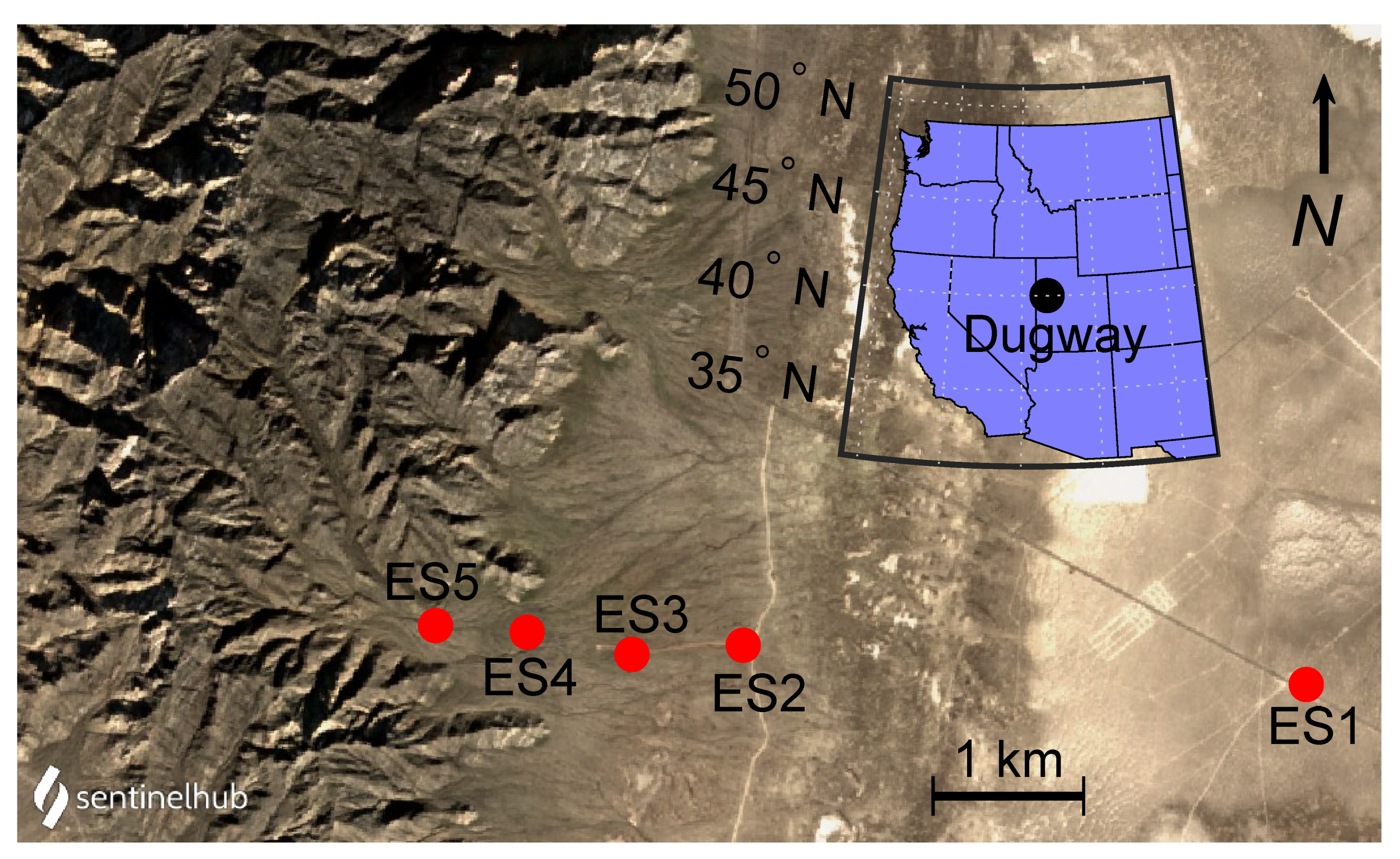
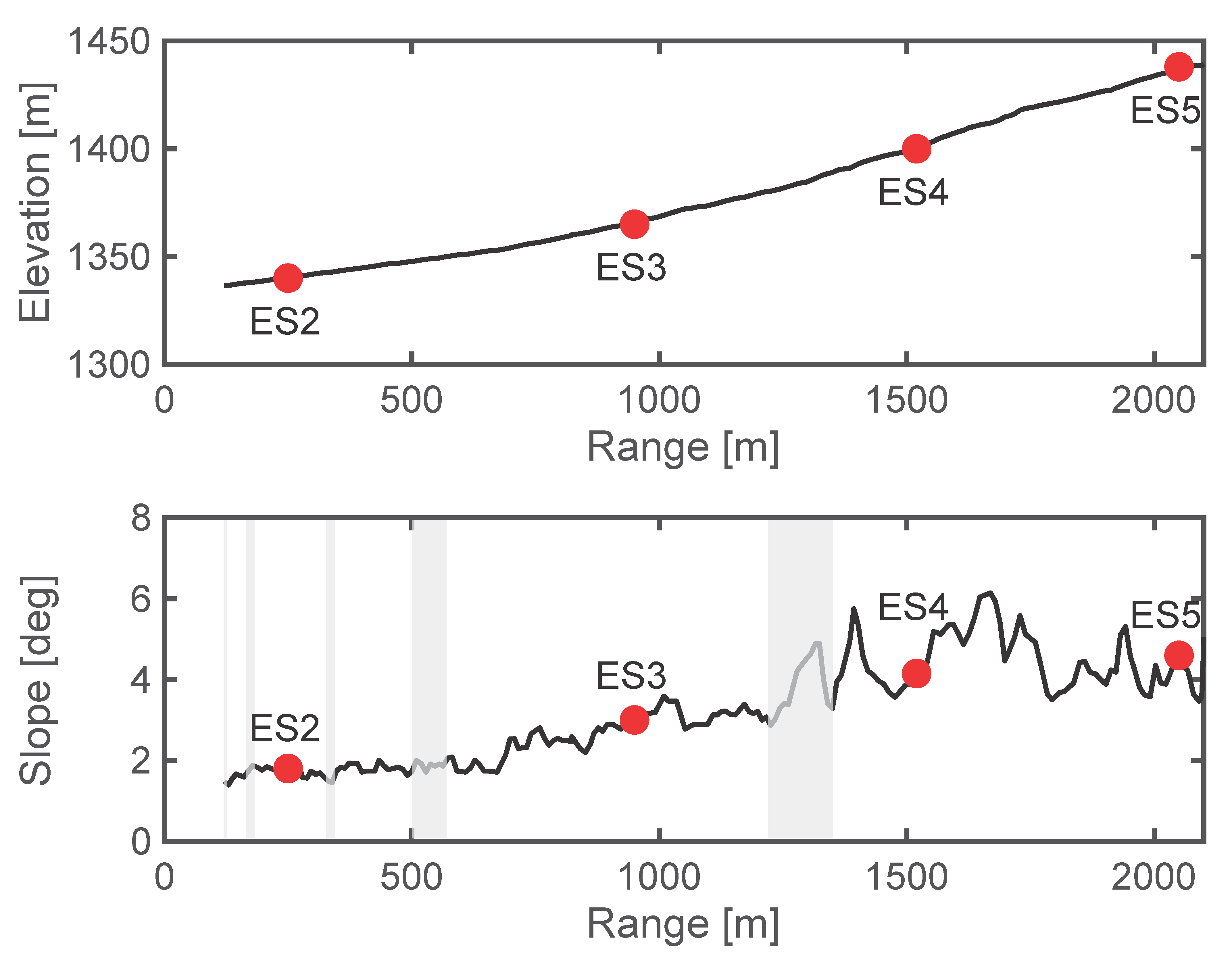
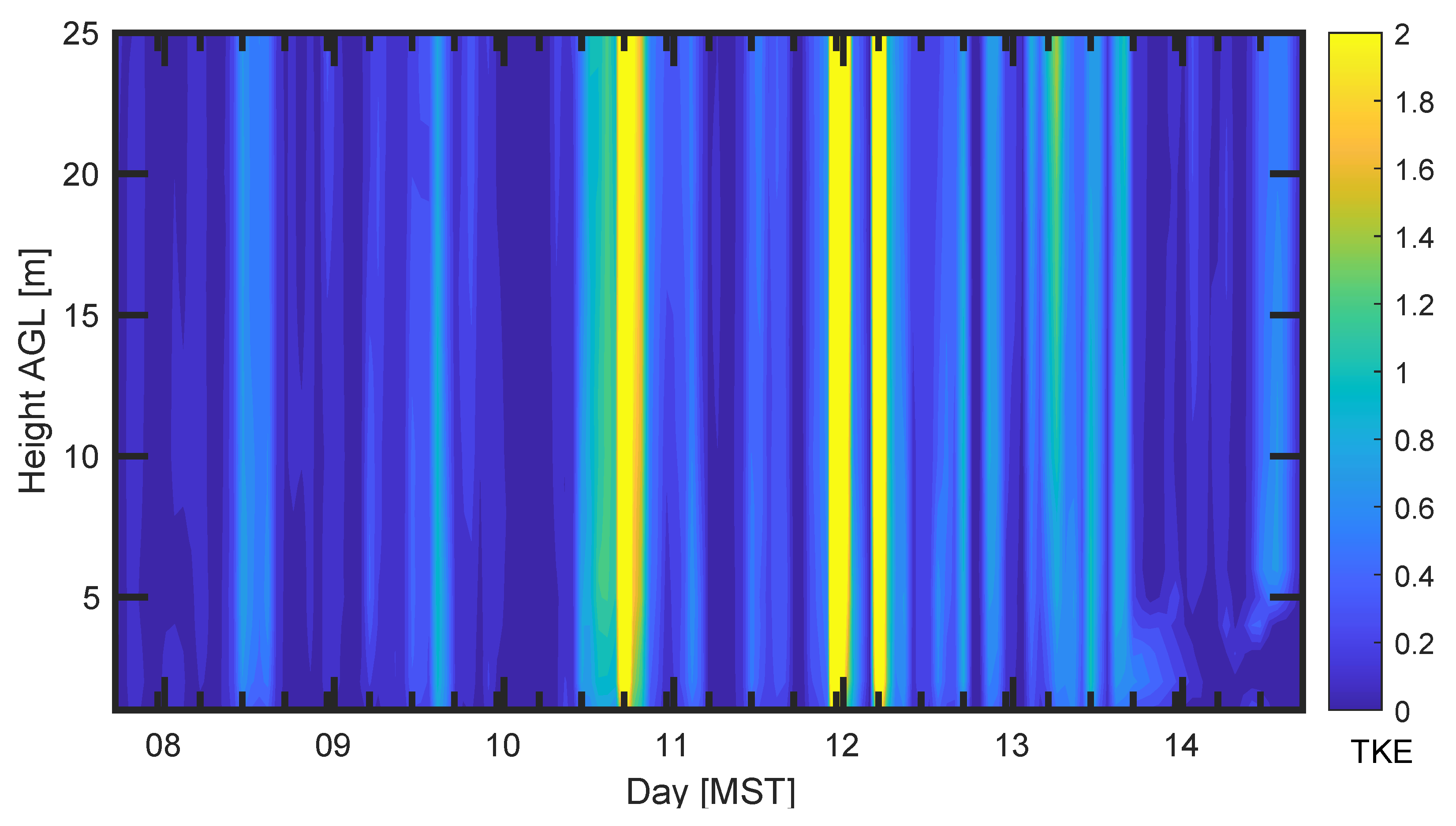

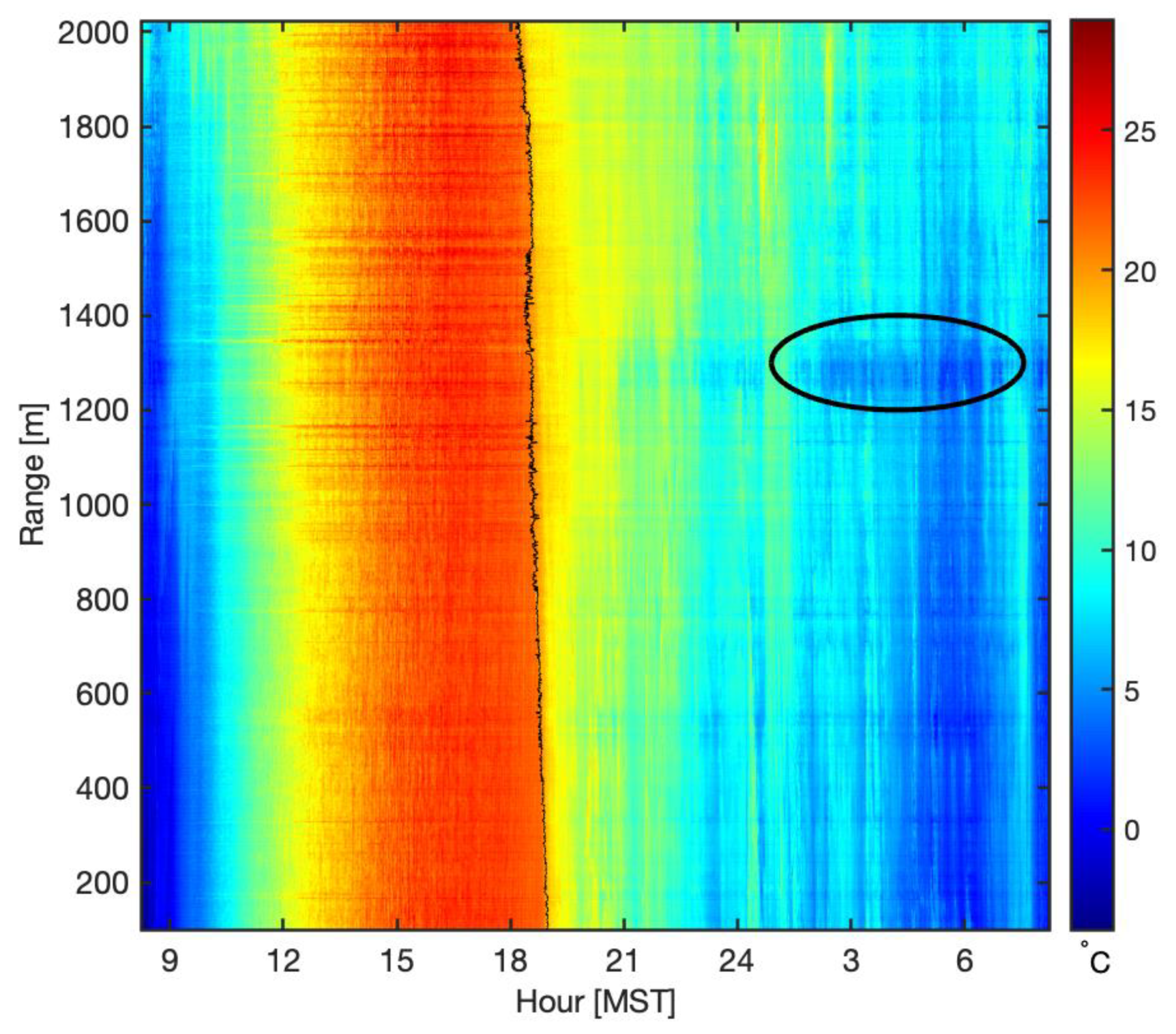

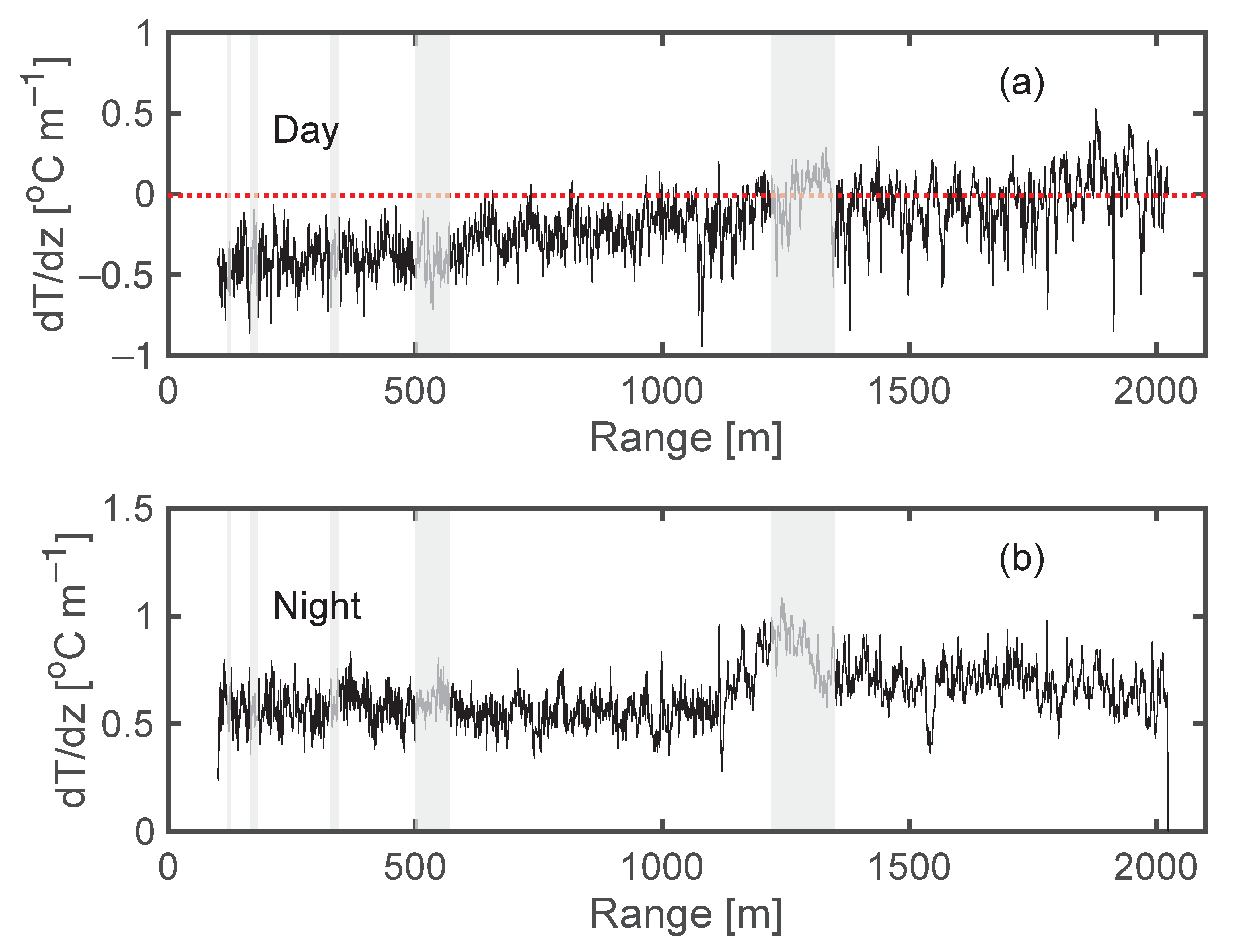

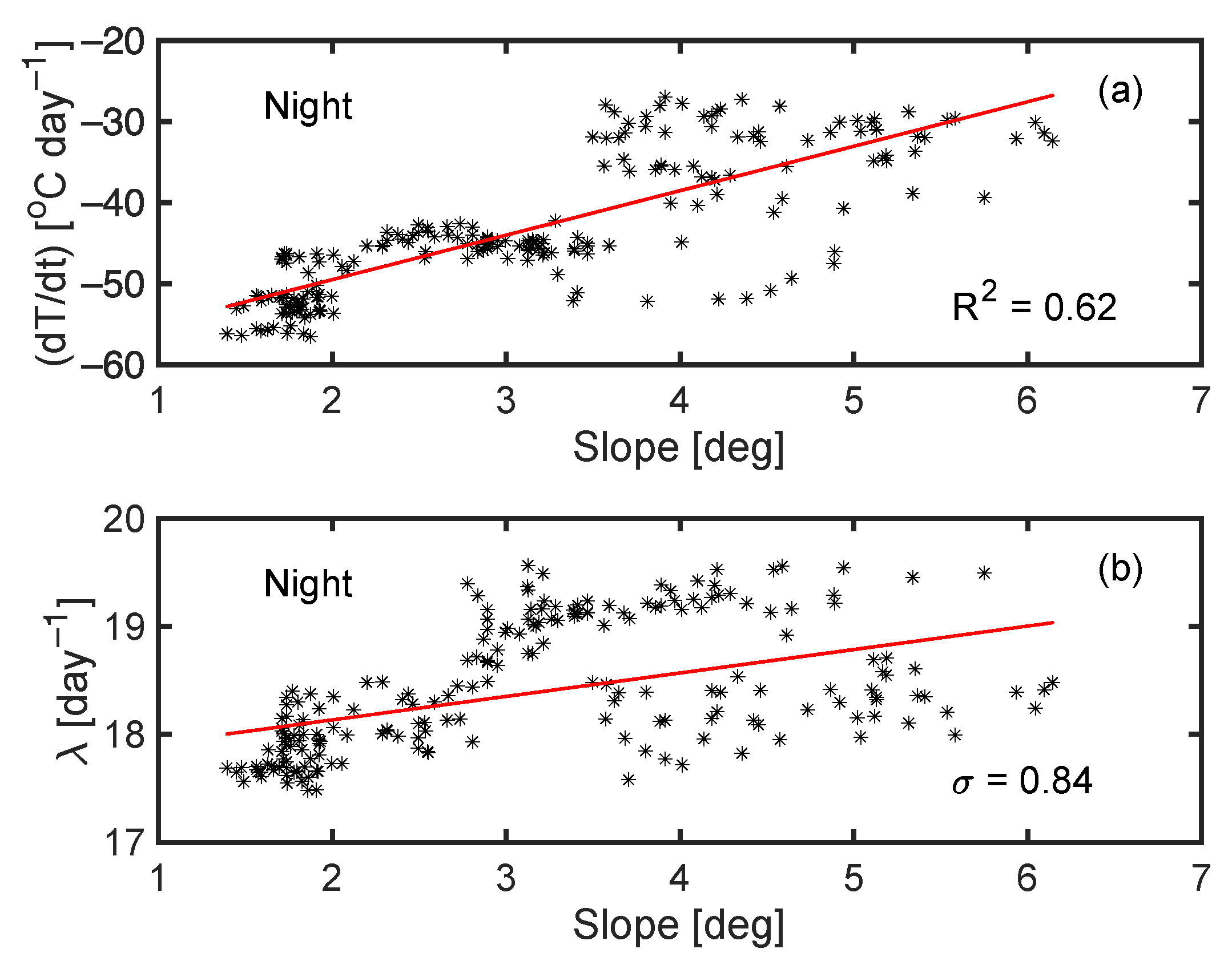
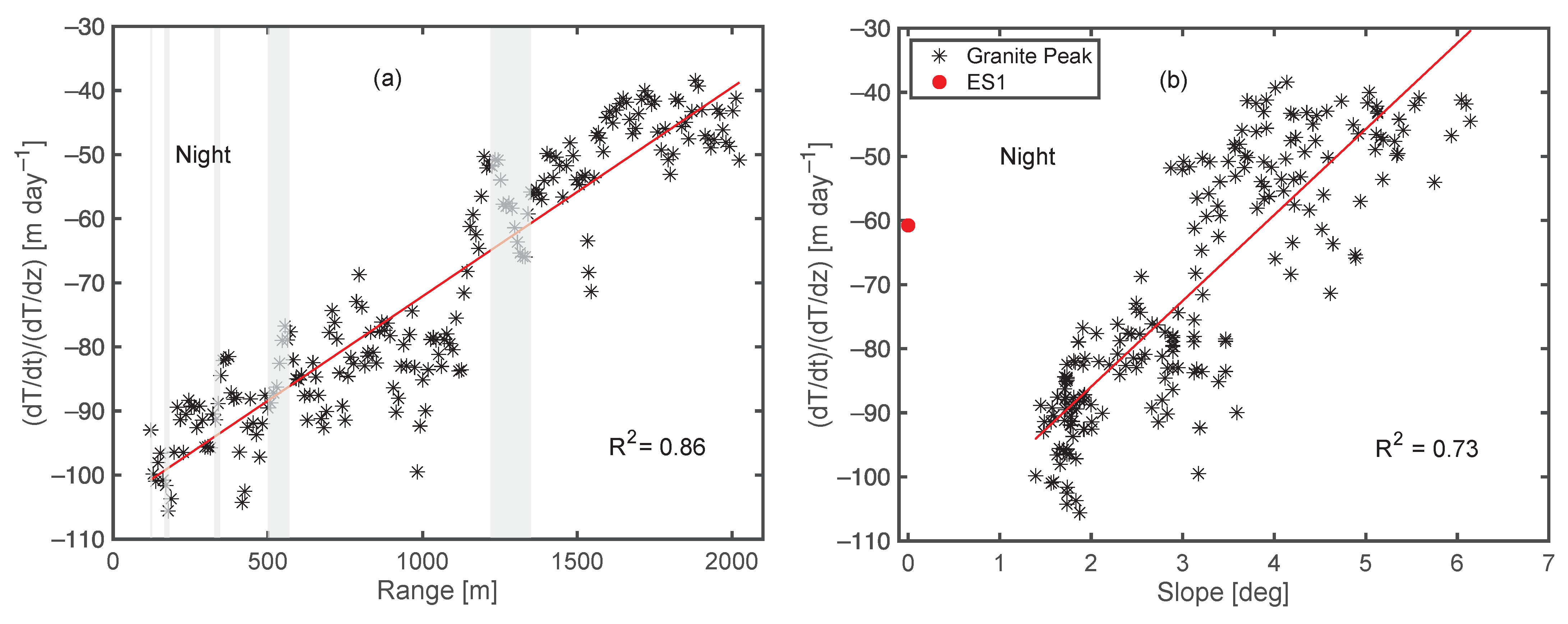
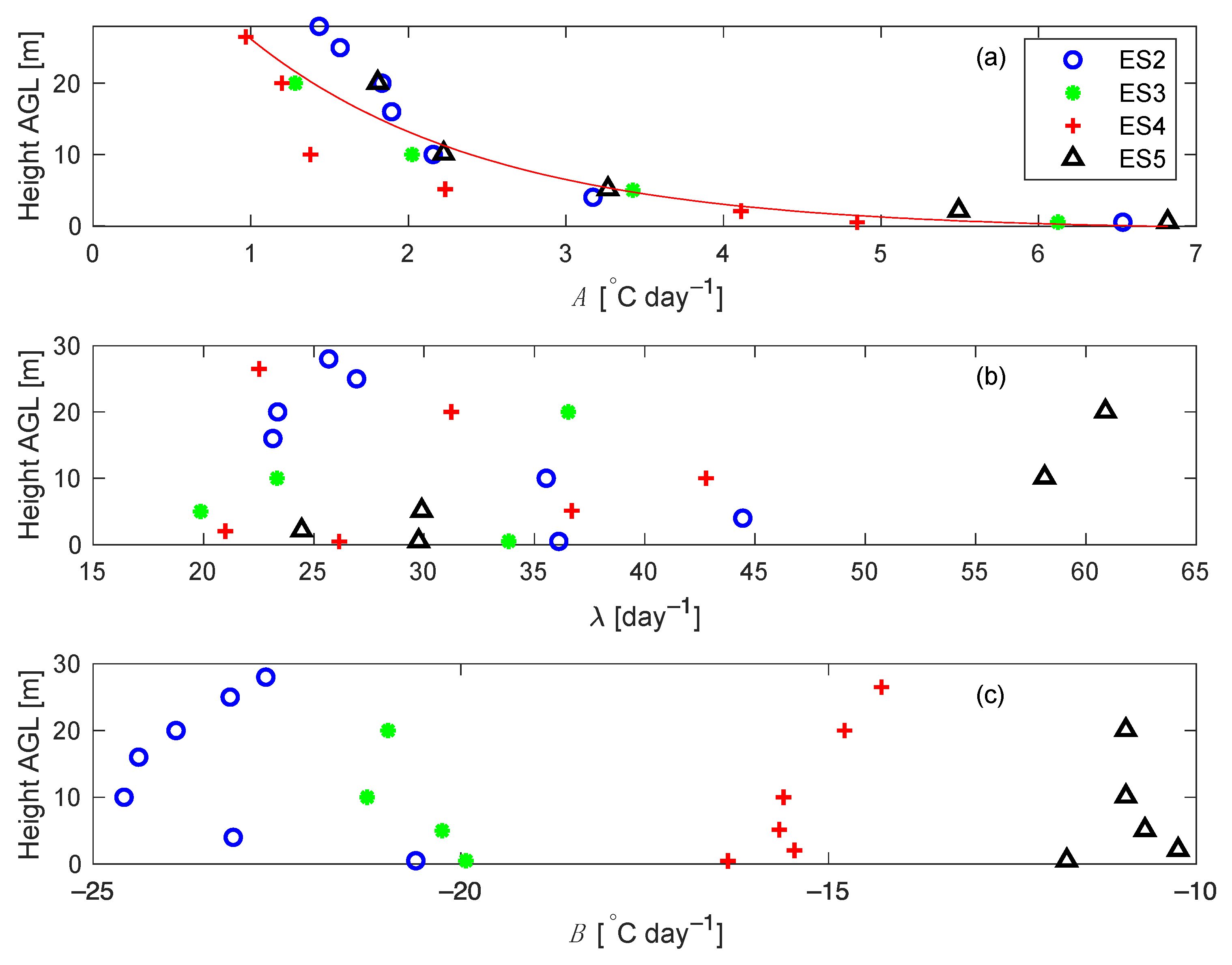
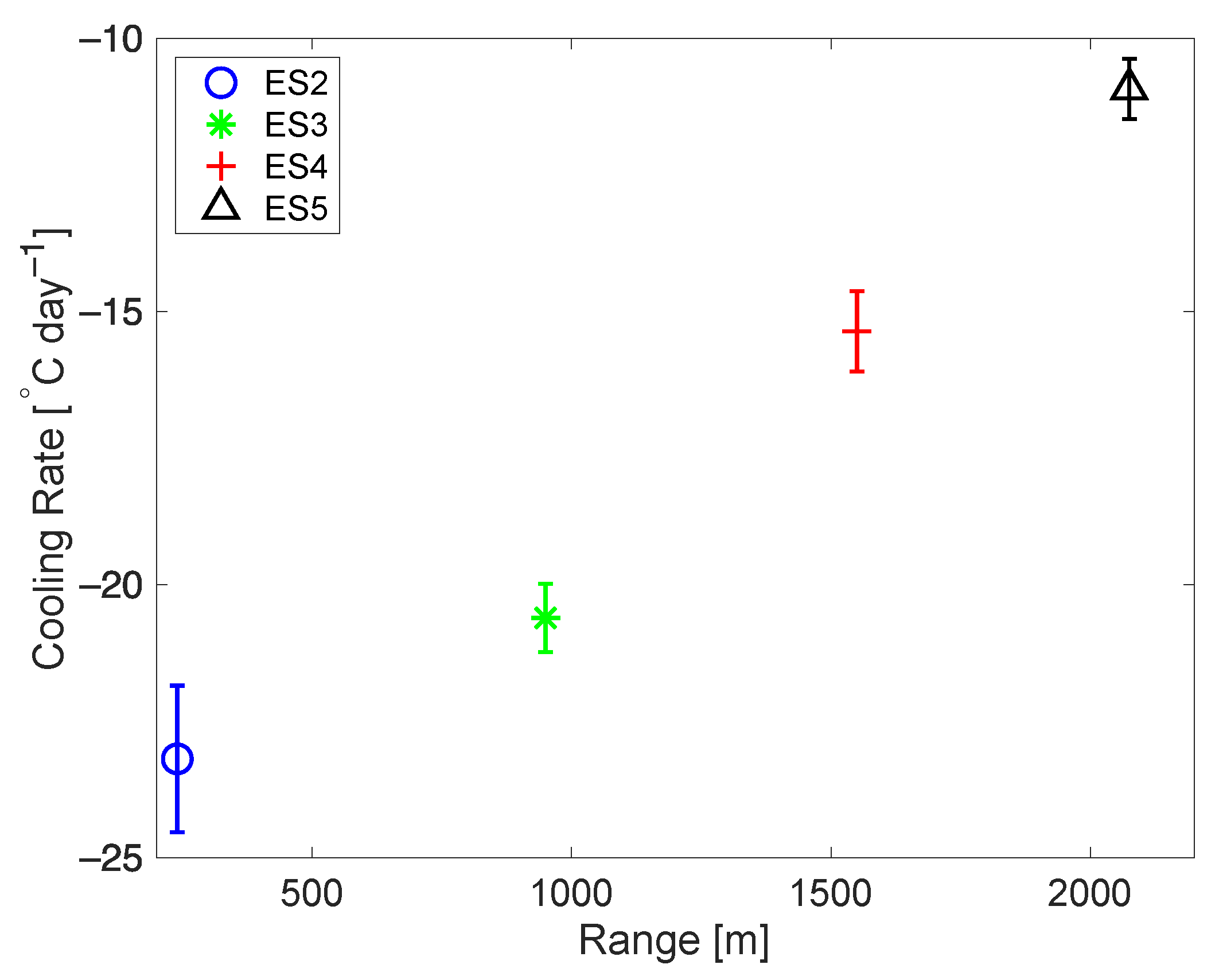
Publisher’s Note: MDPI stays neutral with regard to jurisdictional claims in published maps and institutional affiliations. |
© 2021 by the authors. Licensee MDPI, Basel, Switzerland. This article is an open access article distributed under the terms and conditions of the Creative Commons Attribution (CC BY) license (https://creativecommons.org/licenses/by/4.0/).
Share and Cite
Drake, S.; Higgins, C.; Pardyjak, E. Distinguishing Time Scales of Katabatic Flow in Complex Terrain. Atmosphere 2021, 12, 1651. https://doi.org/10.3390/atmos12121651
Drake S, Higgins C, Pardyjak E. Distinguishing Time Scales of Katabatic Flow in Complex Terrain. Atmosphere. 2021; 12(12):1651. https://doi.org/10.3390/atmos12121651
Chicago/Turabian StyleDrake, Stephen, Chad Higgins, and Eric Pardyjak. 2021. "Distinguishing Time Scales of Katabatic Flow in Complex Terrain" Atmosphere 12, no. 12: 1651. https://doi.org/10.3390/atmos12121651
APA StyleDrake, S., Higgins, C., & Pardyjak, E. (2021). Distinguishing Time Scales of Katabatic Flow in Complex Terrain. Atmosphere, 12(12), 1651. https://doi.org/10.3390/atmos12121651





